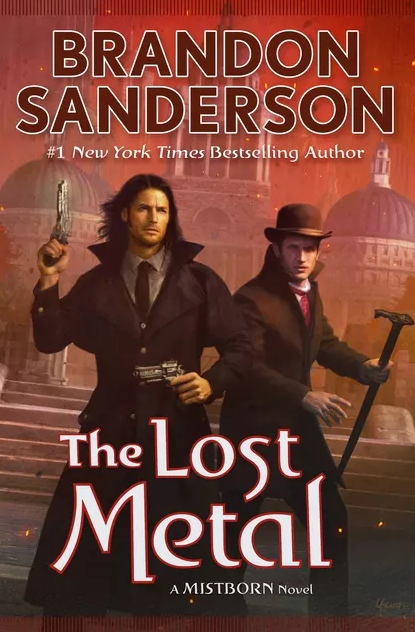Well we’ve made it. The end of an era. Specifically, the end of the 2nd era of Mistborn novels by Brandon Sanderson.
We’ve followed Waxillium Ladrian, Wayne (lolz Wayne doesn’t have a last name), and Marasi Colms through three previous adventures, each of which has tested our heroes not only against the worst criminals, conspirators, and evil gods in the Cosmere, but also against the conventions, tropes and themes of several different genres of Fantasy as well.
In Alloy of Law, we had the perfect alloy of a rough(s) and tumble(weed) Western mixed with Sanderson’s typical Fantasy stylings. Shadows of the Self focused on the city, and the inner depths of character, like noir but with fantasy elements. And The Bands of Mourning took on the deconstruction of Action-Adventure, with perhaps somewhat mixed results.
What is left then for The Lost Metal?
Honestly it’s pretty hard to pin down. The comparison which stands out to me the most is actually like a kind of “team up” style Superhero Film. Like the 2012 Avengers movie, in which a group of characters must work together to solve a really big problem.
This is most obvious in the Marasi chapters as she literally teams up with an Avengers-like organization, partnering with (primarily) two other heroes from other places within the Cosmere to keep an evil army from another planet from coming to Scadrial (Wow that is actually JUST like The Avengers lol).
But there is enough going on (perhaps too much going on) in The Last Metal that a one-to-one genre comparison is difficult, and perhaps not really useful anyway, because this book does not seem to be doing the same kind of deconstructive work that we’ve seen in previous Era 2 titles. It does not focus on trope subversion (it seems to play all the aforementioned super-hero stylings pretty straight) and seems to generally be trying to do its own thing.
While I felt this was somewhat a shame — part of my enjoyment of the previous books was exactly that kind of genre spoofing — ultimately I still enjoyed the book because of how it progressed the overarching Cosmere narrative, which (without spoilers) was basically to blow the whole thing wide open.
If you’re even a little bit of a Cosmere junkie, this book will be like crack cocaine for you. There are so many little details dropped so casually that my head was pretty much spinning the entire time trying to process it all. Did I know this bit of info before? Should I have seen this coming? Where does this fit in?
These were the questions going through my mind at almost every point within the novel, but especially during the aforementioned Marasi chapters. Like woah.
If these are not the parts of the story you enjoy, or if this is somehow your first Cosmere book (weird flex starting on the fourth book of a series but ok), then it’s hard to say what your experience will be. I’ll admit that even I had to eventually just let these details go by as there was too much to fully investigate or consider. And once I kinda stopped paying attention to the all the Cosmere connections, I still feel the story was serviceable if somewhat crowded.
Finally, I felt myself getting a bit sad, and almost grieving a little while reading this one, as it is presumably the last Wax and Wayne book we’ll read. And with that realization, came the realization that there was still so much I had hoped to see and explore before these stories were through.
For instance . . . the entire Malwish (southern?) territories. Perhaps they will get their own spin off in like a Dawnshard/Edgedancer type novel or novella, but so far as I know, this has yet to be announced. Sigh . . .
Give This One A Read?
Yep! If you’ve been trying to “keep up with the Cosmere” I think it’s virtually a must. If you’re just looking for a good send off of these beloved characters, I’d say The Lost Metal is a satisfying read on this front as well.
If you’re hoping for the same kind of nuanced commentary and genre deconstruction present in previous outings of the series, you may be somewhat disappointed as I didn’t feel this book continued that approach, but ultimately I did feel that it was an enjoyable read overall.
That’s all I have for this week. Has anyone read this one yet? What were your thoughts? Were there any lingering questions you wanted answered? Any places you wished you could have seen? Let me know in the comments. I’m looking forward to talking about this one!
Until next time!

